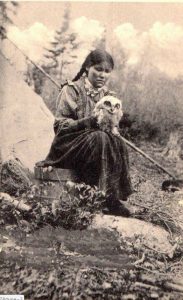Among the different American Indian tribes, there are many diverse beliefs regarding the Owl. Presented here are some of those beliefs.

c. 1910s: Indian woman and owl, Blind River, Ontario
To an Apache Indian, dreaming of an Owl signified approaching death.
Cherokee shamans valued Eastern Screech-Owls as consultants as the owls could bring on sickness as punishment.
The Dakota Hidatsa Indians saw the Burrowing Owl as a protective spirit for brave warriors.
The Hopis Indians see the Burrowing Owl as their god of the dead, the guardian of fires and tender of all underground things, including seed germination. Their name for the
Burrowing Owl is Ko’ko, which means “Watcher of the dark” They also believed that the Great Horned Owl helped their Peaches grow.
The Inuit believed that the Short-eared Owl was once a young girl who was magically transformed into an Owl with a long beak. But the Owl became frightened and flew into the side of a house, flattening its face and beak.
Native Northwest coast Kwagulth people believed that owls represented both a deceased person and their newly-released soul.
The Kwakiutl Indians were convinced that Owls were the souls of people and should therefore not be harmed, for when an Owl was killed the person to whom the soul belonged would also die.
The Lenape Indians believed that if they dreamt of an Owl it would become their guardian.
The Menominee people believed that day and night were created after a talking contest between a Saw-whet Owl (Totoba) and a rabbit (Wabus). The rabbit won and selected daylight, but allowed night time as a benefit to the vanquished Owl.
The Montagnais people of Quebec believed that the Saw-whet Owl was once the largest Owl in the world and was very proud of its voice. After the Owl attempted to imitate the roar of a waterfall, the Great Spirit humiliated the Saw-whet Owl by turning it into a tiny Owl with a song that sounds like slowly dripping water.
To the Mojave Indians of Arizona, one would become an Owl after death, this being and interim stage before becoming a water beetle, and ultimately pure air.
According to Navajo legend, the creator, Nayenezgani, told the Owl after creating it “…in days to come, men will listen to your voice to know what will be their future”
California Newuks believed that after death, the brave and virtuous became Great Horned Owls. The wicked, however, were doomed to become Barn Owls.
In the Sierras, native peoples believed the Great Horned Owl captured the souls of the dead and carried them to the underworld.
The Tlingit Indian warriors had great faith in the Owl; they would rush into battle hooting like Owls to give themselves confidence, and to strike fear into their enemies.
A Zuni legend tells of how the Burrowing Owl got its speckled plumage: the Owls spilled white foam on themselves during a ceremonial dance because they were laughing at a coyote that was trying to join the dance. Zuni mothers place an Owl feather next to a baby to help it sleep.
